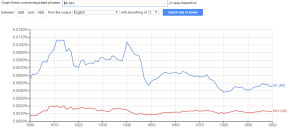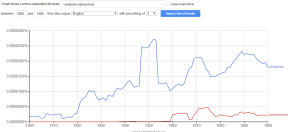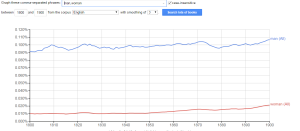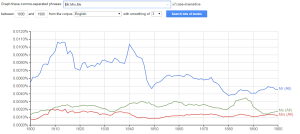Vampires and Werewolves:
For my first Ngram I decided to do a basic, silly search. It is clear that the 1800’s were most definitely Team Edward. I plugged “vampires” (blue) and “werewolves” (red) in expecting vampires to have more prominence, but I didn’t foresee the huge gap there clearly is. I was also shocked to find that Dracula did not create too large of a spike for vampires. Looking at the graph, I had assumed that Bram Stoker’s Dracula would have been published around 1845. However, a quick Google Search told me that Dracula was actually published in 1897, which on the graph seems to be one of the decline stages. So, what could have caused such a spike in the 1840s? Wikipedia tells me that Varney the Vampire, by Sheridan Le Fanu was published in 1847, but that’s a book I’ve never even heard of. It’s surprising that a book like Dracula, that caused no spike, would survive the century while a book that was clearly more popular when it was published would be less known.
Mr vs Mrs:
In this Ngram, I plugged in “man” (blue) and “woman” (red), and was completely floored by my results. However, I quickly realized that men were probably referred to as “man” more frequently than women were referred to as “woman”.
This Ngram did not surprise me as much as the last one did. I plugged in “Mr” (blue) and “Mrs” (red) for this one, for how often people were referred to by their names. However, I was still a little taken aback. The 1800’s were clearly a different time, everyone knows that. Everyone knows that men were more “important” than women in this time period. Yet, I didn’t realize that men were even mentioned more in literature than women were. At least, that was before I realized that both “Mrs” and “Ms” must be taken into consideration.
In this Ngram, I plugged in “Mr” (blue), “Mrs” (red), and “Ms” (green). This made my results make a little bit more sense. However, it is still clear that men were referred to much more in literature in the first half of the 19th century than women were.


